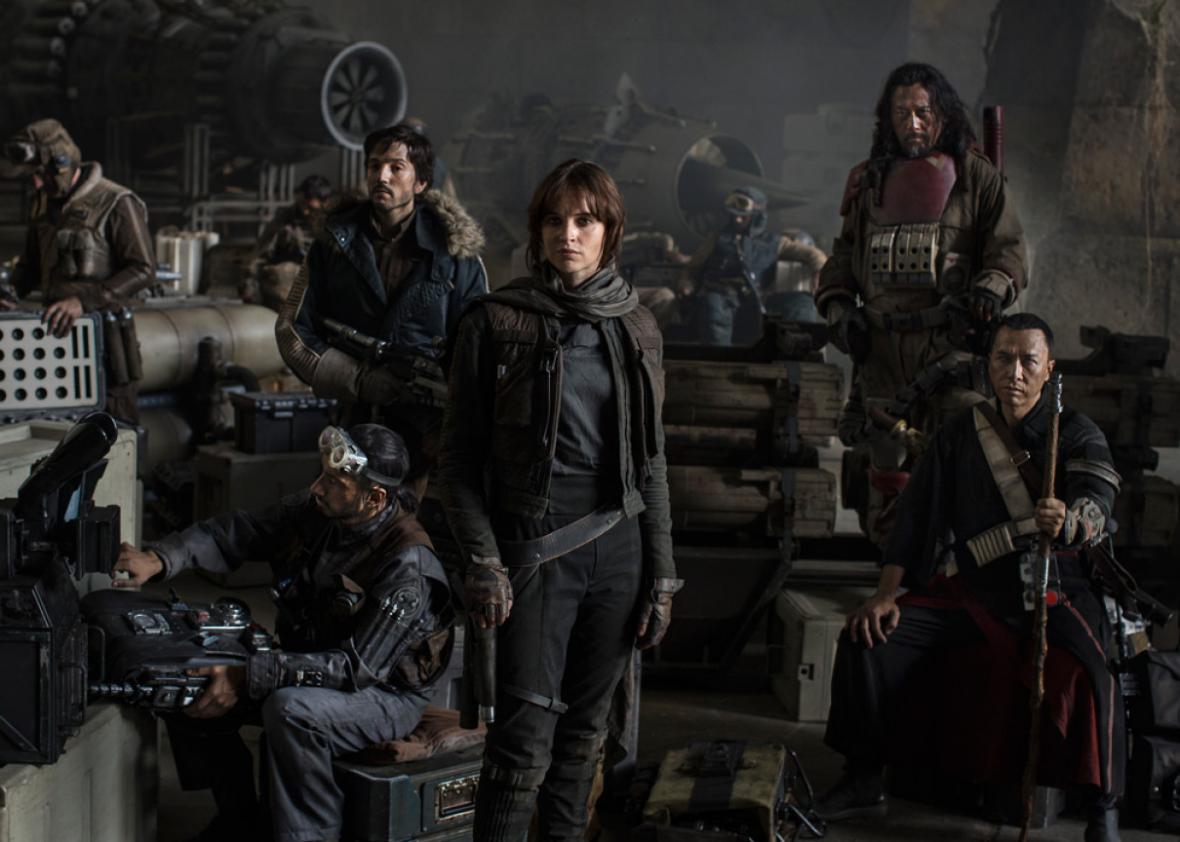The Force Awakens may have brought the Star Wars universe to a new generation of fans, but like the prequels before, it did so at the expense of the original three movies. After the prequels, it was hard to fully savor Darth Vader’s deliciously evil presence when you knew he used to be a lighthearted boy named Ani. Similarly, the rebels’ victory over the Empire at the end of Return of the Jedi rings hollow knowing the Republic will be menaced by a nearly identical threat only a few decades later.
Rogue One has an easier task than either the prequels or the new trilogy in progress; it’s telling a smaller story, with characters who don’t need to outlast a single film. But it’s also the first live-action addition to the franchise since Lucas first set it aside in 1983 that actually improves the movies it’s connected to. (Spoilers for Rogue One—all of Rogue One—follow.)
Rogue One’s raison d’être is closing a thermal exhaust port–sized plot hole in the original Star Wars: How is it that Imperial scientists with the technological sophistication to build a weapon capable of destroying an entire planet somehow never noticed that they’d built a trench big enough to fly an X-Wing through, leading straight to its most vulnerable point? Chris Weitz and Tony Gilroy’s screenplay, which is based on a story by John Knoll and Gary Whitta, provides a simple and satisfying explanation. The Death Star’s fatal flaw was not an oversight but a booby trap, placed there by its imprisoned chief architect, Galen Erso. Although the Empire ends Rogue One knowing that rebels have stolen the Death Star’s blueprints, its rash destruction of Scarif inconveniently incinerates the only Imperial officer who knows the extent of Galen’s double-cross. (It also demonstrates highly inadvisable cybersecurity practices.) That leaves open the question of why the second Death Star (not to mention The Force Awakens’ Starkiller Base) was built with a similar flaw, but perhaps future Bothan-centric Star Wars spinoffs will explain that as well.
But Rogue One’s significance goes well beyond its plot—which, after all, was previously considered inessential enough to have been dispensed with in two sentences of Star Wars’ opening crawl—to the way it shifts the series’ focus and its understanding of whose stories are worth telling. We’ve always known what the rebel spies did but not how they did it or, more importantly, who they were. Jyn Erso and Cassian Andor and the rest of their intrepid crew were no more than a footnote in the galactic history books, a codicil to the star-spanning history of the Skywalker family. The main Star Wars saga concerns itself with lords and princesses, knights and emperors. Rogue One is a story about grunts and outcasts, believers who’ve lost their faith, and, in some cases, their minds.
Rogue One has rightly been praised for bringing long-overdue diversity to the Star Wars universe (even if it could have used a little more in the way of female roles). It’s a thrill to see great actors such as Riz Ahmed and Donnie Yen take their place in the action-figure canon and to see Felicity Jones and her leading-woman salary carry an entry in the world’s biggest franchise. But it’s bittersweet when you consider how that diversity abruptly vanishes in the next film in the series, made in a time, not so long ago or far away, when Hollywood releases were white by default. It’s as if Jyn and her crew are the Buffalo Soldiers or the Navajo code talkers, their achievements fated to be overwritten with the history of white men. There’s a moment toward the end of Rogue One when the original movie’s X-Wing pilots—some of them taken directly from unused Star Wars footage—arrive on the scene. Even as someone who hasn’t felt a strong emotional attachment to the series in years, I felt a giant smile spread instantly across my face at the familiar sight of Red and Gold Leader. For a moment, it’s like you’re actually watching Star Wars, with all the surprise and delight you felt the first time around. But the excitement of the cavalry’s arrival is complicated when you realize that none of the people on Scarif’s surface are going to make it out alive, and the heroes who survive to be celebrated will largely be white men with shaggy ’70s haircuts and porn-star mustaches.
Going from Rogue One directly into Star Wars is a jarring experience, especially since the new movie lasts right up to the second before the old one begins. Why are we watching two bumbling robots snipe at each other on the sands of Tatooine when thousands of people have just been massacred? And what made Bail Organa think that Darth Vader would buy his daughter’s “diplomatic mission” cover story, even for an instant?
But Rogue One also deepens our understanding of what’s at stake in Star Wars and the sacrifices that have been made to get to this point. We no longer have to wait for the destruction of Alderaan to understand the gravity of the threat the Empire poses, and we more clearly see Leia’s dangerous naiveté in assuming the likes of Vader and Grand Moff Tarkin can be outwitted or reasoned with. Most importantly, we know, even if Luke does not and maybe never will, the stories of the brave men and women (and one sardonic Imperial droid) who laid down their lives just to give him a chance to win the day. In Rogue One, Jyn suggests at one point that the Imperial flag waving across the galaxy is “not a problem if you don’t look up,” but the Star Wars saga has always trained its attention on the heavens. Rogue One is the first movie to show us what happens on the ground.
